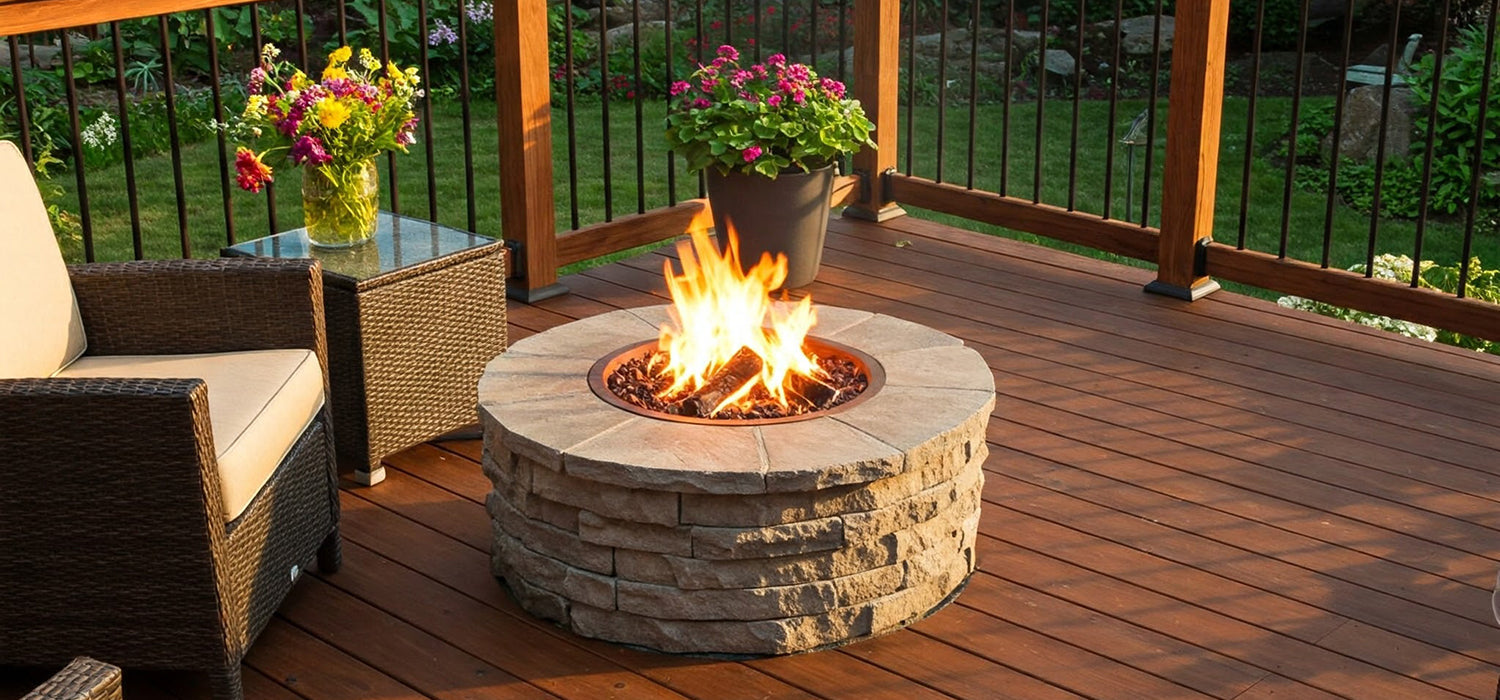
Can You Put a Gas Fire Pit on a Deck?
Can you put a gas fire pit on your deck? Yes—but only if you play it smart. From fire tables to clearance rules, there’s more to it than just “light and relax.” Avoid turning your decking into kindling—read on for safety tips, style picks, and must-know regulations!
Safety Considerations for Deck Surfaces
Combustibility and Heat Damage
Potential for scorching and warping of wood or composite decking
Picture this: you’ve just had a beautiful timber deck installed, and you’re excited to gather round a flickering fire with friends. But after a few uses, you notice dark scorch marks where your gas fire pit sits. Not exactly the rustic vibe you were going for.
Both timber and composite decking can suffer under high heat. They might warp, crack, or fade when exposed to sustained warmth—even from gas fire pits, which are tidier than their wood-burning cousins.
Embers and sparks
While gas fire pits don’t spit embers like a bonfire, they’re not entirely risk-free. A gust of wind can blow the flame sideways, and a sudden whoosh from the burner might kick up sparks.
Even small, unseen embers can cause discolouration or worse, so it's worth treating your deck with care. Fire doesn’t need much to cause trouble—especially on a dry summer evening.
Weight and Stability
Ensuring the deck can support the weight of the fire pit
You wouldn’t plonk a baby grand piano on a garden shed roof, right? Same goes for fire pits on raised decking.
Some fire tables and built-in gas units are deceptively heavy, especially once you factor in a gas cylinder, decorative stones, and any framing. It's essential to know your deck’s load-bearing limits before installation.
If you're not sure, bring in a structural engineer or qualified tradesperson to assess things. A creaky board today could be a collapsed corner tomorrow.
Protective Measures
Heat-Resistant Mats or Barriers
Concrete pavers, stone slabs, or specialised mats
Before you light anything, think insulation. A proper heat barrier underneath your fire pit is a must, especially on wooden or composite surfaces.
Concrete pavers, patio slabs, or specialist fire-resistant mats can do the job brilliantly. They act like oven gloves for your decking, absorbing and deflecting heat where it matters most.
Proper sizing and placement
And size really does matter. Your protective layer should be bigger than your fire pit by at least 60 cm on all sides.
That’s not just for heat—spills, sparks, and shifting equipment all need buffer space. Get this right, and you’ll protect both your deck and your peace of mind.
Clearance and Ventilation
Maintaining a safe distance from combustible materials
This isn’t the time for “it’ll probably be fine.” Fire pits need breathing room—ideally three feet from railings, walls, and furniture.
It might seem like overkill, but the distance protects against both heat damage and accidental contact. No one wants to explain how their lovely new sofa went up in smoke.
Ensuring adequate ventilation
Ventilation is about more than comfort—it’s a safety essential. Gas fire pits release heat and fumes that need to escape freely.
If you’re placing your fire table under a pergola or awning, double-check that the space above it is open and vented. Avoid creating a hotbox where heat builds up and gases can’t clear.
Fire Pit Design and Features
Low-Profile Fire Pits
Reduced heat transfer to the surface
Not all fire pits are created equal. Low-profile models are often better suited for decking because they distribute heat more evenly and keep the hottest bits away from the floor.
They also tend to be more stable and stylish—think of them as the sleek sports cars of the fire pit world. Less smoke, more show.
Built-in Safety Features
Flame height adjustment and safety shut-off
Modern fire pits are smarter than ever. Many models now include safety features like auto shut-off valves, adjustable flame height, and electronic ignition.
These aren’t just fancy extras—they’re vital tools that let you control the flame safely and quickly. Imagine your fire table with a volume knob: more warmth when you need it, and off in a flash if anything goes wrong.
Maintenance and Monitoring
Regular Inspections
Checking for damage or wear
Just like your car needs an MOT, your fire pit needs regular check-ups. Make it a habit to inspect for signs of rust, blockages, or wear and tear.
Look at the gas lines, the burner tray, and any seals. If something looks off, don’t gamble—call a professional. A small fault today could be a safety hazard tomorrow.
Fire Safety Precautions
Having a fire extinguisher or water source nearby
Even with the best fire pit in the world, accidents can happen. That’s why it’s non-negotiable to keep a fire extinguisher, bucket of water, or hose within easy reach.
It’s the classic “better safe than sorry” scenario. If a flame jumps, you’ll be ready—not scrambling in your slippers trying to remember where the extinguisher went.
Conclusion
So, can you put a gas fire pit on a deck? Yes, absolutely—but only with the right prep. With smart choices like low-profile fire tables, heat-resistant barriers, and proper clearance, your decking can safely host that flickering centrepiece of your outdoor space.
It’s not just about installing a fire pit—it’s about creating a space where people feel warm, relaxed, and safe. Follow the steps, keep safety front and centre, and your deck could become the heart of your home, season after season.
And let’s be honest—there’s nothing quite like a quiet evening outside, feet up, fire flickering, and the smell of toasting marshmallows drifting through the air.
Other content we think you'll love
- Is it Safe to Put a Fire Table on Wooden Decking?
- Is It Safe to Put a Fire Table on Composite Decking?
- Can Fire Tables Be Placed on Grass?
- Can You Put a Fire Pit on Fake Grass?
- Will Fire Pit Kill Grass?
- Can You Use a Gas Fire Table Under a Covered Patio?
- Can You Put a Gas Fire Pit Under a Pergola?
- Can You Put a Gas Fire Pit Under a Gazebo?
- The Ultimate Guide to Fire Pits Under Awnings: Safety, Design, and More
- Can You Put a Gas Fire Pit in a Wood Table?
- Is a Gas Fire Pit Considered an Open Fire?
- Can I Have a Fire Pit on My Balcony?
- Fire Pit Under Polycarbonate Roof: Everything You Need to Know

